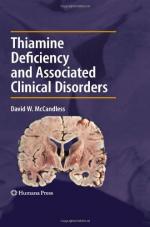|
This section contains 946 words (approx. 4 pages at 300 words per page) |

|
Overview
Thiamine (THYE-uh-min) is the water-soluble vitamin, vitamin B1. It is also known as 3-(4-Amino-2-methylpyrimidyl-5-methyl)-4-methyl-5,β-hydroxyethylthiazolium. It is usually made available as one of its salts, especially thiamine hydrochloride or thiamine mononitrate. Both salts are white crystalline solids with a bitter taste that are destroyed by alkaline solutions. An alkaline solution is one that contains a strong base.
Thiamine was discovered by Japanese scientist Suzuki Umetaro (1874–1943) in the early twentieth century. Umetaro was investigating a disease known as beriberi that had plagued humans for thousands of years. He found that the disease could be cured by feeding patients a diet that contained rice bran. He was also able to isolate a specific compound in rice bran that produced that effect, a compound he named aberic acid. Aberic acid later became known as thiamine.
Key Facts
Other Names:
Vitamin B1
Formula:
C12H17ClN...
|
This section contains 946 words (approx. 4 pages at 300 words per page) |

|


